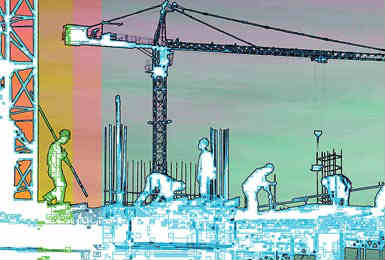Occupancy & Construction Costs: Existing or Build to Suit?
One of the biggest up-front costs for expansion or relocation is occupancy and construction. This factor was ranked fifth in importance by the respondents to Area Development’s 26th Annual Corporate Survey, with 85.9 percent of the respondents considering it high in importance. Fortunately, it is one of the most easily controlled costs.
November 2012

Construction costs include site acquisition, demolition, site preparation, infrastructure improvements, as well as the actual construction of the facility. Sensitive environmental areas, as well as any weak ground conditions that require specialized engineering, will also drive up the cost of site preparation. Method of construction delivery also comes into play — design/build is a cost-effective approach wherein design and construction are performed concurrently. Market prices between cities or regions can vary dramatically when it comes to land, construction, and leasing. Office buildings and headquarters also typically have higher occupancy costs than manufacturing facilities or distribution centers.
“We rely on the RS Means Construction Cost Data when evaluating construction costs for our clients,” indicates Buzz Canup, founder and president of Canup & Associates in Greenville, South Carolina. “It’s a highly reputable source for comparing costs of materials, labor, and construction across the country.”
Data is categorized according to community, region, and industry. Published quarterly, the index shows trends in material and labor costs in 305 cities across the country, as well as provides a historical construction cost index. It is highly useful for fine-tuning cost estimates and comparing cities or regions.
“A construction cost difference of 10 percent between states or cities for construction can be a huge factor, especially for big projects,” adds Canup.
New Versus Renovated
Great deals on land and construction were plentiful during the recession and are still available, although material and construction costs are gradually increasing and general contractors are not as desperate for work. Funding can still be a huge roadblock for new construction — it’s still challenging to get loans for commercial construction, which forces some companies to look at existing buildings that are available.
In general, more companies are interested in locating in existing buildings compared to building a new facility. Not only is this less expensive, but it is also faster; companies can often find suitable properties that have most of what they are looking for and require minimal retrofitting. Even a complete, high-tech renovation takes less time and money than acquiring a property and designing and constructing a modern new facility.
However, when converting an existing building, “be aware that adverse constructability issues can also be numerous,” advises David Cochrane, principal with DLDT Associates in Alpharetta, Georgia. “When considering an existing structure for retrofit and renovation, diligent detailed inspection of the building, with specific consideration to adaptability of the program, is a must. Some pitfalls include environmental contamination and structural deficiencies or deterioration. Central plant capacities; available voltage/phase/amperages for power needs; appropriate domestic, fire, and sewer water services; and floor load capacities must also be evaluated. Many times, if identified during lease negotiations, these types of issues can be pushed back to the landlord for correction. However, many issues that may relate specifically to the tenants’ new-to-be improvements must be part of the project construction cost.”
Sealing the Deal
Economic development incentives and the ability to serve clients are typically the other influential factors for projects where occupancy and construction cost issues are a top concern. “Incentives can help lower project costs, and transportation costs tie in with real estate costs in terms of a selected location,” says Larry Gigerich, managing director for Ginovus in Indianapolis, Indiana. Corporate headquarters, manufacturing, data centers, and R&D centers are typically more sensitive to this factor because they tend to be more expensive operations.
“Even though occupancy and construction costs are important in the site selection process, as a one-time cost they are typically of less concern than the expensive longer-term costs like labor and logistics,” indicates Deane Foote, president of Foote Consulting Group in Phoenix, Arizona. “That said, these costs can also be a deciding factor in the site decision if the finalists are all fairly even. Occupancy and construction costs can also be amortized over a period of 20–50 years, which lessens their impact.”
Ginovus helped Multi-Color Corporation consolidate its manufacturing facilities in the Cincinnati, Ohio, MSA. Occupancy costs, along with labor quality and costs and economic development incentives, were key drivers in the company deciding to consolidate within the MSA.
“There was an opportunity to purchase a building from a Fortune 500 company that had downsized,” says Gigerich. “The company was quite motivated to sell to recover capital and, as a result, occupancy costs were driven lower. The ability of the local community to transfer an existing tax abatement to our client, combined with the support from the state to provide job-creation tax credits, training grant funds, and grant dollars to make building renovations, further reduced project and operating costs,” he concludes.
Project Announcements
Apex Plastics Opens Expanded Production Plant In Brookfield, Missouri
09/22/2014
Japan-Based Bridgestone Rubber-BSA Opens Biorubber Process Research Center In Mesa, Arizona
09/22/2014
SpencerARL Expands Its Plattsburgh, New York, Manufacturing Facility
09/22/2014
Hill International, Inc. Relocates Corporate Headquarters To Philadelphia, Pennsylvania
09/22/2014
Prysmian Group Plans $8.2 Million Expansion At Abbeville County, South Carolina, Manufacturing Center
09/22/2014
Japan-Based Kowa Kentucky Plans $8.3 Million Manufacturing Facility In Corbin, Kentucky
09/22/2014
Most Read
-
The Workforce Bottleneck in America’s Manufacturing Revival
Q4 2025
-
Rethinking Local Governments Through Consolidation and Choice
Q3 2025
-
Lead with Facts, Land the Deal
Q3 2025
-
Investors Seek Shelter in Food-Focused Real Estate
Q3 2025
-
Tariff Shockwaves Hit the Industrial Sector
Q4 2025
-
America’s Aerospace Reboot
Q3 2025
-
The Permit Puzzle and the Path to Groundbreaking
Q3 2025



